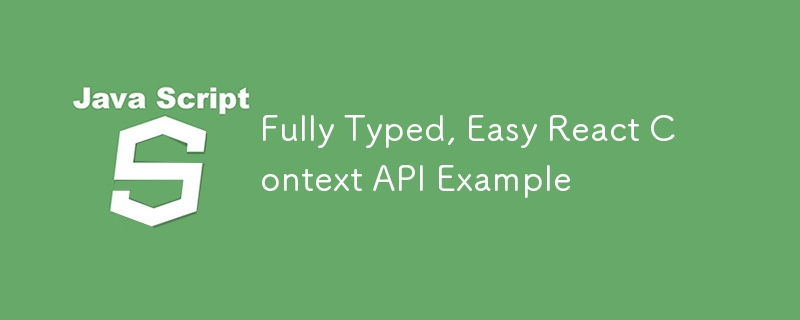完全类型化、简单的 React Context API 示例
发布于2024-11-16

不必照顾上下文类型的技巧很简单!
如果您使用上下文 API,那么一个问题就是其类型的照顾。
另一个是必须使用多个导入才能在需要时使用它。
通过这个示例,我们解决了这两个问题,并使 React Context API 的使用变得快速、简单。
复制粘贴示例
复制、粘贴,然后只需将所有“示例”替换为您需要命名的内容即可。
(之后会有完整注释的版本。)
import {
createContext,
useCallback,
useContext,
useDeferredValue,
useMemo,
useState,
} from 'react';
function useContextValue(init: number = 0) {
const [state, setState] = useState(init);
const doubleValue = state * 2;
const defferedStringValue = useDeferredValue(state.toString());
const reset = useCallback(() => {
setState(init);
}, []);
const value = useMemo(
() => ({
state,
doubleValue,
defferedStringValue,
reset,
}),
[
state,
doubleValue,
defferedStringValue,
reset,
],
);
return value;
}
type ExampleContext = ReturnType;
const Context = createContext(null!);
Context.displayName = 'ExampleContext';
export function ExampleContextProvider({
children,
initValue = 0,
}: {
children: React.ReactNode;
initValue?: number;
}) {
const value = useContextValue(initValue);
return {children} ;
}
export function useExample() {
const value = useContext(Context);
if (!value) {
throw new Error('useExample must be used within a ExampleContextProvider');
}
return value;
}
评论版
import {
createContext,
useCallback,
useContext,
useDeferredValue,
useMemo,
useState,
} from 'react';
/**
* We create a custom hook that will have everything
* that would usually be in the context main function
*
* this way, we can use the value it returns to infer the
* type of the context
*/
function useContextValue(init: number = 0) {
// do whatever you want inside
const [state, setState] = useState(init);
const doubleValue = state * 2;
const defferedStringValue = useDeferredValue(state.toString());
// remember to memoize functions
const reset = useCallback(() => {
setState(init);
}, []);
// and also memoize the final value
const value = useMemo(
() => ({
state,
doubleValue,
defferedStringValue,
reset,
}),
[
state,
doubleValue,
defferedStringValue,
reset,
],
);
return value;
}
/**
* Since we can infer from the hook,
* no need to create the context type by hand
*/
type ExampleContext = ReturnType;
const Context = createContext(null!);
Context.displayName = 'ExampleContext';
export function ExampleContextProvider({
children,
/**
* this is optional, but it's always a good to remember
* that the context is still a react component
* and can receive values other than just the children
*/
initValue = 0,
}: {
children: React.ReactNode;
initValue?: number;
}) {
const value = useContextValue(initValue);
return {children} ;
}
/**
* We also export a hook that will use the context
*
* this way, we can use it in other components
* by importing just this one hook
*/
export function useExample() {
const value = useContext(Context);
/**
* this will throw an error if the context
* is not used within the provider
*
* this also avoid the context being "undefined"
*/
if (!value) {
throw new Error('useExample must be used within a ExampleProvider');
}
return value;
}
最后的话
就是这样。 Context API 比应有的更简单、更精细,但对于需要使用它的情况来说,它是一个强大的工具。
请记住,React Context API 不是 Redux(或其他状态管理器),您不应该将整个应用程序状态放入其中。
嗯,可以,但可能会导致不必要的问题。
这是在 React
版本声明
本文转载于:https://dev.to/noriller/fully-typed-easy-react-context-api-example-4ne5?1如有侵犯,请联系[email protected]删除
最新教程
更多>
-
 C++ 程序员如何使用 NPAPI 开发强大的浏览器插件?制作浏览器插件:C 程序员指南增强网络浏览器的专业功能需要开发浏览器插件。然而,编写这些插件的过程提出了问题,特别是对于那些打算使用 C 为 Windows 编写插件的人。开发浏览器插件的关键在于利用 Netscape 插件应用程序编程接口 (NPAPI)。 NPAPI 使开发人员能够创建处理特定内...编程 发布于2024-11-16
C++ 程序员如何使用 NPAPI 开发强大的浏览器插件?制作浏览器插件:C 程序员指南增强网络浏览器的专业功能需要开发浏览器插件。然而,编写这些插件的过程提出了问题,特别是对于那些打算使用 C 为 Windows 编写插件的人。开发浏览器插件的关键在于利用 Netscape 插件应用程序编程接口 (NPAPI)。 NPAPI 使开发人员能够创建处理特定内...编程 发布于2024-11-16 -
 如何使用 MySQL 查找今天生日的用户?如何使用 MySQL 识别今天生日的用户使用 MySQL 确定今天是否是用户的生日涉及查找生日匹配的所有行今天的日期。这可以通过一个简单的 MySQL 查询来实现,该查询将存储为 UNIX 时间戳的生日与今天的日期进行比较。以下 SQL 查询将获取今天有生日的所有用户: FROM USERS ...编程 发布于2024-11-16
如何使用 MySQL 查找今天生日的用户?如何使用 MySQL 识别今天生日的用户使用 MySQL 确定今天是否是用户的生日涉及查找生日匹配的所有行今天的日期。这可以通过一个简单的 MySQL 查询来实现,该查询将存储为 UNIX 时间戳的生日与今天的日期进行比较。以下 SQL 查询将获取今天有生日的所有用户: FROM USERS ...编程 发布于2024-11-16 -
 如果 `std::move` 实际上没有移动任何东西,为什么它被称为 `std::move`?为什么 std::move 命名为 std::move?std::move 函数尽管有它的名字,但它并不实际上移动任何东西。它只是将左值(引用对象的表达式)转换为右值(表示临时对象的表达式)。此转换是通过转换为 xvalue 类别来执行的,这与左值和纯右值不同。这种命名选择的原因可以追溯到该概念的历...编程 发布于2024-11-16
如果 `std::move` 实际上没有移动任何东西,为什么它被称为 `std::move`?为什么 std::move 命名为 std::move?std::move 函数尽管有它的名字,但它并不实际上移动任何东西。它只是将左值(引用对象的表达式)转换为右值(表示临时对象的表达式)。此转换是通过转换为 xvalue 类别来执行的,这与左值和纯右值不同。这种命名选择的原因可以追溯到该概念的历...编程 发布于2024-11-16 -
 如何在悬停时使元素背景颜色变暗而不影响透明度?使用 CSS 使元素背景颜色变暗增强用户界面涉及通过改变交互元素(例如按钮)的外观来突出显示它们。一种常见的方法是在悬停时使背景颜色变暗。最初,人们可能会尝试调整不透明度,但这会影响颜色和透明度。存在更有针对性的解决方案。方法:叠加深色图层使用背景图像创建深色叠加层。该方法保留了原始文本颜色,同时使...编程 发布于2024-11-16
如何在悬停时使元素背景颜色变暗而不影响透明度?使用 CSS 使元素背景颜色变暗增强用户界面涉及通过改变交互元素(例如按钮)的外观来突出显示它们。一种常见的方法是在悬停时使背景颜色变暗。最初,人们可能会尝试调整不透明度,但这会影响颜色和透明度。存在更有针对性的解决方案。方法:叠加深色图层使用背景图像创建深色叠加层。该方法保留了原始文本颜色,同时使...编程 发布于2024-11-16 -
 CSS3 转换与 jQuery 动画:iPad HTML5 应用程序哪个更快?性能比较:CSS3 转换与 jQuery 动画在 iPad HTML5 应用程序中,您实现了触摸事件以提高响应速度并利用用于元素操作的 jQuery。然而,您正在争论是使用 jQuery 动画还是 CSS3 动画转换。让我们深入研究一下它们的性能比较。根据基准研究,jQuery 动画的执行速度明显慢...编程 发布于2024-11-16
CSS3 转换与 jQuery 动画:iPad HTML5 应用程序哪个更快?性能比较:CSS3 转换与 jQuery 动画在 iPad HTML5 应用程序中,您实现了触摸事件以提高响应速度并利用用于元素操作的 jQuery。然而,您正在争论是使用 jQuery 动画还是 CSS3 动画转换。让我们深入研究一下它们的性能比较。根据基准研究,jQuery 动画的执行速度明显慢...编程 发布于2024-11-16 -
 Bootstrap 4 Beta 中的列偏移发生了什么?Bootstrap 4 Beta:列偏移的删除和恢复Bootstrap 4 在其 Beta 1 版本中引入了重大更改柱子偏移了。然而,随着 Beta 2 的后续发布,这些变化已经逆转。从 offset-md-* 到 ml-auto在 Bootstrap 4 Beta 1 中, offset-md-*...编程 发布于2024-11-16
Bootstrap 4 Beta 中的列偏移发生了什么?Bootstrap 4 Beta:列偏移的删除和恢复Bootstrap 4 在其 Beta 1 版本中引入了重大更改柱子偏移了。然而,随着 Beta 2 的后续发布,这些变化已经逆转。从 offset-md-* 到 ml-auto在 Bootstrap 4 Beta 1 中, offset-md-*...编程 发布于2024-11-16 -
 三元条件运算符在编程中如何工作?理解三元条件运算符编程中,使用问号(“?”)和冒号(“:”)运算符括号内形成三元条件运算符。它提供了传统 if-else 语句的简洁替代方案,允许您评估条件并根据其真实性分配值。语法和用法The三元运算符遵循语法:boolean_expression ? true_value : false_val...编程 发布于2024-11-16
三元条件运算符在编程中如何工作?理解三元条件运算符编程中,使用问号(“?”)和冒号(“:”)运算符括号内形成三元条件运算符。它提供了传统 if-else 语句的简洁替代方案,允许您评估条件并根据其真实性分配值。语法和用法The三元运算符遵循语法:boolean_expression ? true_value : false_val...编程 发布于2024-11-16 -
 如何访问 Maven 依赖项的源代码和 Javadoc?在 Maven 存储库中查找源 JARMaven 是一种流行的 Java 项目包管理工具,提供了广泛的库及其依赖项存储库。通常,开发人员需要访问与这些依赖项关联的源代码或 Javadoc,以进行调试或文档记录。虽然 Maven 存储库通常存储二进制 JAR 文件,但有一种方法可以使用 Maven 检...编程 发布于2024-11-16
如何访问 Maven 依赖项的源代码和 Javadoc?在 Maven 存储库中查找源 JARMaven 是一种流行的 Java 项目包管理工具,提供了广泛的库及其依赖项存储库。通常,开发人员需要访问与这些依赖项关联的源代码或 Javadoc,以进行调试或文档记录。虽然 Maven 存储库通常存储二进制 JAR 文件,但有一种方法可以使用 Maven 检...编程 发布于2024-11-16 -
 扩展 Quarkus:何时以及如何编写自己的扩展Quarkus 凭借其创新的扩展框架,为开发人员提供了一种将各种技术无缝集成到其应用程序中的强大方法。这些扩展简化了配置、启用依赖项注入并优化了性能,使其成为 Java 开发人员的一个有吸引力的选择。然而,在深入创建您自己的 Quarkus 扩展之前,了解何时需要以及如何有效地做到这一点至关重要。 ...编程 发布于2024-11-16
扩展 Quarkus:何时以及如何编写自己的扩展Quarkus 凭借其创新的扩展框架,为开发人员提供了一种将各种技术无缝集成到其应用程序中的强大方法。这些扩展简化了配置、启用依赖项注入并优化了性能,使其成为 Java 开发人员的一个有吸引力的选择。然而,在深入创建您自己的 Quarkus 扩展之前,了解何时需要以及如何有效地做到这一点至关重要。 ...编程 发布于2024-11-16 -
 如何在 JavaScript 中将数组作为函数参数传递?在 JavaScript 中将数组作为函数参数传递将数组作为单独的参数传递给函数可能是乏味且低效的。考虑以下代码:const x = ['p0', 'p1', 'p2']; call_me(x[0], x[1], x[2]); // Unwieldy and prone to errors解决方案1...编程 发布于2024-11-16
如何在 JavaScript 中将数组作为函数参数传递?在 JavaScript 中将数组作为函数参数传递将数组作为单独的参数传递给函数可能是乏味且低效的。考虑以下代码:const x = ['p0', 'p1', 'p2']; call_me(x[0], x[1], x[2]); // Unwieldy and prone to errors解决方案1...编程 发布于2024-11-16 -
 如何在 PHP 中组合两个关联数组,同时保留唯一 ID 并处理重复名称?在 PHP 中组合关联数组在 PHP 中,将两个关联数组组合成一个数组是一项常见任务。考虑以下请求:问题描述:提供的代码定义了两个关联数组,$array1和$array2。目标是创建一个新数组 $array3,它合并两个数组中的所有键值对。 此外,提供的数组具有唯一的 ID,而名称可能重合。要求是构...编程 发布于2024-11-16
如何在 PHP 中组合两个关联数组,同时保留唯一 ID 并处理重复名称?在 PHP 中组合关联数组在 PHP 中,将两个关联数组组合成一个数组是一项常见任务。考虑以下请求:问题描述:提供的代码定义了两个关联数组,$array1和$array2。目标是创建一个新数组 $array3,它合并两个数组中的所有键值对。 此外,提供的数组具有唯一的 ID,而名称可能重合。要求是构...编程 发布于2024-11-16 -
 为什么 Docker 在 macOS 上的性能比在本机 Linux 系统上慢?macOS 上的 Docker 性能问题在 macOS 中运行 Docker 时,用户经常会遇到明显的性能限制,从而成为高效开发的障碍。这个问题源于 macOS 上 Docker 架构的基本性质。Docker 需要 Linux 内核才能运行,但 macOS 本身并不提供 Linux 内核。相反,它使...编程 发布于2024-11-16
为什么 Docker 在 macOS 上的性能比在本机 Linux 系统上慢?macOS 上的 Docker 性能问题在 macOS 中运行 Docker 时,用户经常会遇到明显的性能限制,从而成为高效开发的障碍。这个问题源于 macOS 上 Docker 架构的基本性质。Docker 需要 Linux 内核才能运行,但 macOS 本身并不提供 Linux 内核。相反,它使...编程 发布于2024-11-16 -
 如何根据同名其他行的数据更新表中的空值?在表中的行之间复制数据在数据库管理中,经常需要根据表中其他行的数据来更新行同一张桌子。考虑一个包含 ID、NAME 和 VALUE 列的表,其中包含重复的 NAME 值,如下所示:ID | NAME | VALUE | ---------------------------- 1...编程 发布于2024-11-16
如何根据同名其他行的数据更新表中的空值?在表中的行之间复制数据在数据库管理中,经常需要根据表中其他行的数据来更新行同一张桌子。考虑一个包含 ID、NAME 和 VALUE 列的表,其中包含重复的 NAME 值,如下所示:ID | NAME | VALUE | ---------------------------- 1...编程 发布于2024-11-16 -
 为什么在 Go 中使用 mgo 时我的“_id”字段为空?使用 mgo 在 Go 中检索“_id”字段值的问题排查本文解决了无法检索“_id”字段值的问题当将 mgo 与 Go 一起使用时。尝试从 MongoDB 数据库获取数据时遇到了问题。首先,代码片段定义了一个名为“Article”的结构体,它表示数据库中的文档。它包含“_id”、“title”、“a...编程 发布于2024-11-16
为什么在 Go 中使用 mgo 时我的“_id”字段为空?使用 mgo 在 Go 中检索“_id”字段值的问题排查本文解决了无法检索“_id”字段值的问题当将 mgo 与 Go 一起使用时。尝试从 MongoDB 数据库获取数据时遇到了问题。首先,代码片段定义了一个名为“Article”的结构体,它表示数据库中的文档。它包含“_id”、“title”、“a...编程 发布于2024-11-16
学习中文
- 1 走路用中文怎么说?走路中文发音,走路中文学习
- 2 坐飞机用中文怎么说?坐飞机中文发音,坐飞机中文学习
- 3 坐火车用中文怎么说?坐火车中文发音,坐火车中文学习
- 4 坐车用中文怎么说?坐车中文发音,坐车中文学习
- 5 开车用中文怎么说?开车中文发音,开车中文学习
- 6 游泳用中文怎么说?游泳中文发音,游泳中文学习
- 7 骑自行车用中文怎么说?骑自行车中文发音,骑自行车中文学习
- 8 你好用中文怎么说?你好中文发音,你好中文学习
- 9 谢谢用中文怎么说?谢谢中文发音,谢谢中文学习
- 10 How to say goodbye in Chinese? 再见Chinese pronunciation, 再见Chinese learning

























